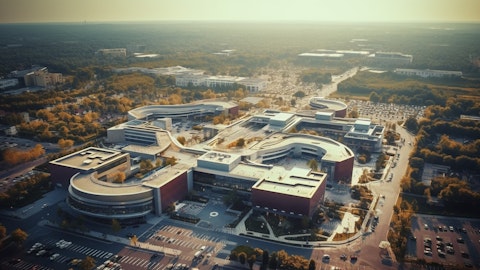Ross Cooper: Juan, I think from a merchandising mix standpoint, the pharmacy has evolved almost like become a mini mart in many ways. So when you go into a pharmacy, the script business is always in the back. And then you walk through all the aisles of higher margin items. And I think what happened there is the script business got disrupted and then their pricing on the call it traditional grocery items were elevated versus other options that the consumer had. And so clearly, they’re going through a transition period of having Amazon and others come into the prescription business and then what the front of the house looks like. So the good news from the real estate point of view is typically those deals were done on ground leases and were done on pads or positions up in front of the shopping center that are highly valuable.
So I think we have the ability to recapture some of those with drive-thrus, repurpose and actually get a significant mark-to-market on spaces that we get back. It’s probably unlikely we’ll see a lot of them coming back to us because they typically are the most valuable pieces of real estate in the shopping center. But it is one that I think we have the opportunity to reset if we do get our hands on a few of them.
Operator: The next question comes from Samir Khanal of Evercore ISI. Please go ahead.
Samir Khanal: Hey Conor, just looking at the shop occupancy for the RPT portfolio, I think sequentially was down 40 basis points here. Is there something to read into that, considering that we’ve seen sequential increases for a while now, or is that sort of you being more proactive as you sort of delete space for greater opportunities? Thanks.
Conor Flynn: That was the upside of the deal for us. We actually think that that’s really sort of the juice to be squeezed because we see the small shop momentum continuing. If you look at the Kimco portfolio and the sequential gain we had there, and some of the — obviously, the leasing we had on, on the RPT portfolio out of the gates was way ahead of our anticipation. So clearly, when we look at the upside of the deal, there’s going to be a lot of momentum on the leasing side on the small shops because some of those shopping centers that have lower small shop occupancy are actually where we’re building out anchor spaces. And so, for example, in Florida, we’ve got a Publix under construction and Trader Joe’s under construction.
And a lot of those small shops are vacant because there’s no anchor there yet. But we know the momentum of having those types of grocers open are going to be significant to the leasing momentum. So it gives us a lot of cautious optimism that, we’re in the right spot. The business model is working well. We can continue to focus on executing and building out those spaces efficiently, and then lease-up the surrounding spaces, so far, so good, in terms of the integration.
Ross Cooper: Yes. I would just add that when we acquired RPT, their small shop occupancy was over 200 basis points lower than ours. So when you blended it all together again, because it’s obviously a much smaller portfolio, the impact at the end was only about 40 basis points.
Conor Flynn: We can go to the next question.
Operator: The next question comes from Haendel St. Juste of Mizuho. Please go ahead.
Haendel St. Juste: Hey there, good morning. I wanted to follow-up, Ross, on some comments you made about the transaction market, the challenge of redeploying capital into dispositions, from the disposition here. Can you talk a bit about the range of cap rates you’re seeing out there for the quality you want to buy versus what you need to see to be more active? And maybe why do you think cap rates will move higher in the back of year or perhaps see more opportunity, trying to get a better understanding why you’re not getting more active now, and if the JV capital could play a role as well. Thank you.
Ross Cooper: Sure. Yes. I mean, the JV capital can certainly play a role. But to answer your question, we’re fortunate that we have a variety of ways to put out capital. So the acquisition — the core acquisitions, we continue to be very disciplined. You saw last year, very modest amount of traditional core acquisitions, because when the market is not where our cost of capital is, we stay patient. We lean into structured, we lean into leasing, we lean into redevelopments, and we have other ways to place capital. So today, as I mentioned, the core kind of neighborhood grocery-anchored shopping centers are in that plus or minus 6 cap range with where we are today, that doesn’t necessarily fit for us. But our hope is that that changes either with our cost of capital being more aggressive as the year progresses, or you see a little bit of a softening in the pricing, it’s depending on macro conditions.
You’ve seen one of our peers out in the market with a substantial amount of, call it more commodity power. Those are still trading in the 7 to 7.5, upper 7 cap range. So there’s clearly capital that’s chasing those assets. We’re not really focused on commodity power today that doesn’t have the growth profile that we’re looking for. So, Floris’ earlier question, you’ve seen some sort of lifestyle type assets. Those are, as Conor mentioned, really lending into a lot of the other categories. So it is a bit of a hybrid, depending on whether there’s a grocery component, what type of shop space you have. So the pricing levels there and cap rates really range pretty significantly. Where we see opportunity for us, again, I’ll reference the Stonebridge asset that we acquired last year.
Some of the larger check sizes really eliminates a significant amount of the bidder pool. We can utilize our platform to be a bit more aggressive on those types of assets, but still maintain yields that are attractive to us. And the CAGR on the deal that the growth rate is really critical to us. That’s not simply just the going in cap rate, but where can we actually utilize our team to move that cash flow and increase it. So that’s something that we’re very focused on. If we don’t believe that we can do that, it doesn’t really matter what the going in cap rate is, we’re not going to require it. So as I mentioned in the remarks, the structured investment program is one that we continue to field a lot of questions, conversations, interest level.
I think there’s going to be a bit more activity there. Where we can participate in assets that perhaps have a broken capital stack but not broken real estate. You like those opportunities and we think there’s going to be more of it. So on a blend; we’re still confident that we’re going to be able to put out capital at accretive rates, even if the core acquisition opportunities remain pretty tight.
Operator: The next question comes from Craig Mailman of Citi. Please go ahead.



